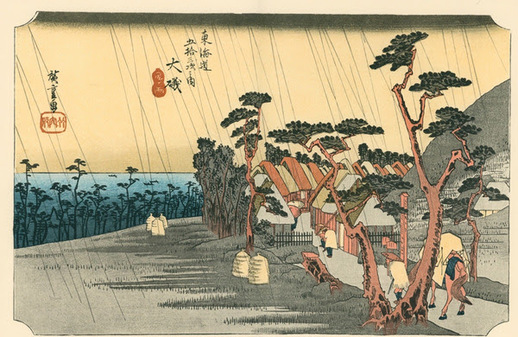2024.11.28
コラム/エッセイ宙ちゃんの「伝統文化一直線」 第14回 世界で初めて描かれた霧と雨
近藤宙時=日本伝統文化検定協会理事

歌川広重「東海道五拾三次之内・大磯 虎ヶ雨」
伝統文化と聞くと、「古臭いもの」「昔のこと」と思う方も多いかも知れません。しかし、「古い」と簡単に切り捨てることが難しいのが伝統文化です。なぜなら、知らず知らずのうちに、その文化の中で育った人の考え方から物の見方にまで影響を及ぼすものだからです。極端なケースになると、何と遺伝子にまで影響を及ぼしてしまうほどです。
例えば、生海苔(のり)を消化できるのは日本人だけといわれています(焼き海苔は日本人以外も消化できるそうなのでお間違えなく)。大昔から生海苔を食べてきた伝統的な食文化が、知らず知らずのうちに遺伝子レベルにまで影響を及ぼしてしまう。この「知らず知らずのうちに」というのが伝統文化のすごいところです。
伝統文化を知っていれば、異なる文化で育った人の、自分とは違う物の見方を「そういう見方もあるのか」と受け入れることができます。ところが、伝統文化を知らないと、かえって自分の物の見方が人類不変の法則のように思えて、異なる文化を受け入れ難くなってしまいがちです。だからこそ、伝統文化はきちんと知っておく必要があるのです。
話は変わりますが、ジョゼフ・マロード・ウィリアム・ターナーという画家をご存じでしょうか。わずか26歳で英国ロイヤルアカデミーの正会員となった、ロマン主義を代表する風景画家です。初めて霧を描いたことでも知られ、「ターナーが現れるまで、ロンドンに霧はなかった」とさえいわれています。この言葉は象徴的で、伝統文化の一つである絵画が人々の物の見方を変えてしまう力を持っていることを示しています。ターナーが描くまで、ロンドン市民にとって霧は霧でしかありませんでした。
翻って日本においては、ターナーの200年以上も前に、長谷川等伯が「松林図屏風(びょうぶ)」で霧を描き切っています。さすがは四季の国、天気に敏感な農耕の民に受け継がれてきた遺伝子の成せる業としか言いようがない作品です。この絵は、どこか恐ろしささえ漂わせる霧の寂寥(せきりょう)たる雰囲気と同時に、その美しさをも人々に感じさせました。
長谷川等伯が霧を描いてから約170年後、ターナーが生まれる前に、多色刷り木版画である錦絵の元祖と呼ばれ、浮世絵と聞くと誰もが思い浮かべる鈴木春信が、「風俗四季歌仙 五月雨」や「雨夜の宮詣(見立蟻通図)」で、雨を線で表現しました。
人物を浮き立たせるための、いわばアクセントとして雨を使った春信に続き、歌川広重は「東海道五拾三次之内」の8番目の宿場「大磯」(図版としては9番目)で、そぼ降る雨を線で写実的に描写。45番目の「庄野」(副題「白雨」)では、雨を完全な主役として描き切りました。その後も、ゴッホが模写したことで世界的に有名な「名所江戸百景」の「大はしあたけの夕立」など、さまざまな表情を持つ雨を題材に取り、雨といえば多くの人が広重の絵を思い浮かべるようになりました。それがマンガやアニメの表現にまでつながっていることは皆さんご存じの通りです。
ちなみに「大磯」の副題は「虎ケ雨」。俳句の夏の季語である「虎が雨」は旧暦5月の終わり頃に降る雨のことで、曾我兄弟の仇(あだ)討ちで知られる曾我十郎が5月28日の決行後に命を落とした際、彼と恋仲であり、大磯の遊女だったともいわれる虎御前が涙したことに由来しています。つまり、広重の雨の絵は、現代のマンガ・アニメだけでなく、「曾我物」と呼ばれる能や浄瑠璃、歌舞伎といった芸能とも、ここでつながっているのです。
蛇足になりますが、広重の辞世の歌を紹介したいと思います。
「東路(あずまぢ)へ 筆を残して 旅の空 西の御国(みくに)の 名所(などころ)を見む」
まさに不世出の風景画家の面目躍如。解説はよしましょう。
【English Version】
chu-chan's Mastering Traditional Culture
No.14 Fog and Rain Painted for the First Time in the World
Kondo Chuujii= Director, Japan Traditional Culture Certification Association

Hiroshige Utagawa, “Tokaido Gojyuusan-tsugi no uchi, Oiso, Toragaame” (The Five Pilgrimage of the Tokaido Highway, Oiso, Japan)
Many people may think that traditional culture is “old-fashioned” or “something from the past”. However, it is difficult to simply dismiss traditional culture as “old”. This is because, unknowingly, it influences everything from the way people who grew up in the culture think to the way they see things. In extreme cases, it can even affect one's genes.
For example, it is said that only Japanese people can digest raw nori (laver) (make no mistake, non-Japanese people can also digest grilled laver). The traditional food culture that has been eating raw nori since ancient times unknowingly influences the genetic level. This “unknowingly” is the amazing thing about traditional culture.
If you know the traditional culture, you can accept the different views of people who grew up in different cultures. However, if one does not know traditional culture, one's own way of looking at things tends to seem like an immutable law of humankind, making it difficult to accept different cultures. This is why it is necessary to know about traditional culture.
By way of digression, have you ever heard of the painter Joseph Mallord William Turner? He was a leading landscape painter of the Romantic period who became a full member of the Royal Academy of Fine Arts at the age of only 26. He is also known for having painted fog for the first time, and it is even said that “there was no fog in London until Turner appeared. This saying is symbolic and shows that painting, a traditional culture, has the power to change the way people see things. Until Turner painted it, fog was just fog to Londoners.
In Japan, more than 200 years before Turner, Hasegawa Tohaku depicted fog in his “Pine Trees. This work can only be said to be the result of the genes inherited from the agricultural people, who are sensitive to the weather in this land of the four seasons. This painting evokes an atmosphere of desolate fog that is even somewhat frightening, but at the same time it also makes people feel the beauty of the fog.
About 170 years after Hasegawa Tohaku painted fog and before Turner was born, Suzuki Harunobu, known as the originator of nishiki-e, a multicolor woodblock print and the artist everyone thinks of when they hear the word ukiyoe, expressed rain in lines in “Fuzoku Shiki Utaisen: Summer Rain” and “Ameya no Miyamotodate (Ameya no Miyamotodate)”.
Following Harunobu, who used rain as an accent, Utagawa Hiroshige depicted rain falling in a realistic manner with lines in “Oiso,” the eighth inn (ninth in the series) of “The Five Pilgrimage of Tokaido,” and in “Shono,” the 45th inn (subtitled “White Rain”), he depicted rain as a complete main character. Later, he continued to use rain with various expressions as his subject matter, including the world-famous “O-hashi-atake no Yudare” from “Meisho Edo hyakkei” (One hundred Famous Views of Edo), which Van Gogh copied, and many people came to think of Hiroshige's paintings when rain was mentioned. As we all know, this has even led to manga and anime representations.
Incidentally, the subtitle of “Oiso” is “Toraga-rain. A summer term in haiku, “Toraga-rain” refers to the rain that falls around the end of May on the lunar calendar, and derives from the fact that when Soga Juro, known for his revenge against the Soga brothers, lost his life after his decision on May 28, Toragozen, who was in love with him and is said to have been a prostitute in Oiso, wept. In other words, Hiroshige's rain paintings are connected here not only to modern manga and anime, but also to the performing arts of Noh, Joruri and Kabuki, known as “Soga-mono.
As an addition, I would like to introduce Hiroshige's poem of resignation.
“To the east, I will leave my brush and look at the famous sights of the western lands.”
It truly shows the depth of insight of an inimitable landscape painter. Let's not comment on it.
カテゴリー: コラム/エッセイ
関連タグ: #歌川広重 #ターナー #長谷川等伯 #松林図屏風 #東海道五拾三次之内・大磯 虎ヶ雨





